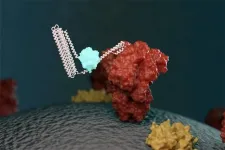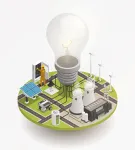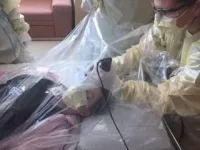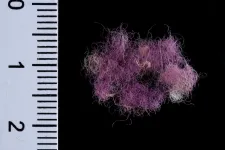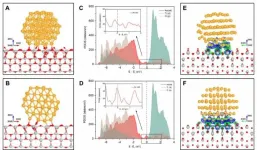Immune system sets 'tripwire' to protect against viruses
Cell defenses have evolved to turn the tables on viral attacks by using bait and sounding an alarm
2021-01-28
(Press-News.org) Scientists are opening new windows into understanding more about the constantly shifting evolutionary arms race between viruses and the hosts they seek to infect. Host organisms and pathogens are in a perennial chess match to exploit each other's weaknesses.
Such research holds tantalizing clues for human health since the immune system is on constant alert to deploy counter measures against new viral attacks. But unleashing too much of a defensive response can lead to self-inflicted tissue damage and disease.
A new study published in the journal eLife by biologists at the University of California San Diego has revealed insights on the intricate, adaptive mechanisms of a protective system employed by the cells of mammalian immune systems. Through a multidisciplinary approach that combined bioinformatics, biochemistry and virology, Biological Sciences graduate students Brian Tsu, Chris Beierschmitt and Andy Ryan, Assistant Professor Matt Daugherty and their collaborators at UC Berkeley found surprising defensive functions coordinated by a protein called NLRP1, which serves as a sensor for invasive pathogens.
The study involved Picornaviridae family viruses, which generate proteases, or molecular "scissors," that can cleave and activate NLRP1. These viruses include human pathogens such as poliovirus, coxsackievirus (responsible for hand, foot and mouth disease) and rhinovirus (one of the most frequent causes of the common cold). The analysis revealed that NLRP1 has recently evolved to "sense" these viral proteases through a type of trap that sets off an immune response in reaction to being cut by the viral proteases. Interestingly, NLRP1 has evolved to do this by mimicking natural sites that the viral protease normally needs to cut in order for the virus to replicate, making it difficult for the virus to avoid cleaving NLRP1 while maintaining its ability to survive.
"In our paper we're showing that NLRP1 acts to bait viral protease cleavage and set off a sort of alarm, or tripwire, in the organism," said Tsu, the lead author of the study. "This is like an Achilles heel to the virus. This allows the host organism to evolve ways to take advantage of this evolutionarily constrained cleavage."
Daugherty said the results offer an interesting switch of conventional beliefs about virus-host dynamics.
"We often think of viruses taking advantage of the fact that hosts evolve slowly, but we're seeing that the hosts have turned the tables and used the fact that the viruses are really stuck here to their advantage, and therefore they use this constraint to activate an immune response."
While evolution is often considered to occur one step after another, the viruses analyzed in this study would need to simultaneously alter numerous regions within their viral proteins to evolve around the tripwire defense, which would be extremely difficult.
The research was derived in cells but lays the groundwork for potential future clinical applications in which the tripwire function could be employed in immune defenses in human systems such as the lungs, brain and other areas. Based on the study's results in individual cells, new research avenues are opening to investigate how the tripwire operates across entire organisms.
"I'm particularly excited about looking for more of these cases because this is an evolutionarily elegant way of detecting and responding to viral infection," said Daugherty.
INFORMATION:
The full author list includes: Brian Tsu, Christopher Beierschmitt, Andrew Ryan, Rimjhim Agarwal, Patrick Mitchell and Matt Daugherty.
The research was funded by the National Institutes of Health (R35 GM133633), Pew Biomedical Scholars Program, Hellman Fellows Program, a National Science Foundation graduate research fellowship (2019284620) and a Jane Coffin Childs Memorial Fund for Medical Research postdoctoral fellowship.
[Attachments] See images for this press release:
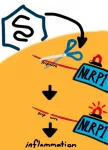
ELSE PRESS RELEASES FROM THIS DATE:
2021-01-28
Scientists have created a new way to detect the proteins that make up the pandemic coronavirus, as well as antibodies against it. They designed protein-based biosensors that glow when mixed with components of the virus or specific COVID-19 antibodies. This breakthrough could enable faster and more widespread testing in the near future. The research appears in Nature.
To diagnose coronavirus infection today, most medical laboratories rely on a technique called RT-PCR, which amplifies genetic material from the virus so that it can be seen. This technique requires specialized staff and equipment. It also consumes lab supplies ...
2021-01-28
Housing instability and homelessness are widely understood to have an impact on health, and certain housing problems have been linked to specific childhood health conditions, such as mold with asthma. But it has not been clear how overall housing quality may affect children--especially those who are at risk from other social determinants of health such as food insecurity or poverty.
A new nationally representative study in the Journal of Child Health Care, led by researchers at Nationwide Children's Hospital, has found poor-quality housing is independently associated with poorer pediatric health, ...
2021-01-28
As states and municipalities begin to roll out mass vaccination campaigns, some people have dared to ask: When will it be safe to resume "normal" activities again? For those in most parts of the United States, the risk of COVID-19 infection remains extremely high.
People now have access to better real-time information about infection rates and transmission at the county or city level, but they still need a framework to help them decide what is safe to do. Social distancing and shutting businesses have reduced the number of cases, but there is mounting pressure to reopen businesses and classrooms.
Life is likely to continue in this limbo for some time. A new model co-authored by ...
2021-01-28
A University of Otago study explored factors which influence Americans' levels of concern over climate change, providing discussion on how those factors could impact mitigation efforts.
A key thread of the research examined the ability of people to visualize the future. Results showed that while 74 per cent of respondents were concerned about climate change, only 29 per cent discussed lower carbon options when asked to describe travel in the year 2050.
"This suggests actively envisioning a sustainable future was less prevalent than climate change concern. So while the majority were concerned, ...
2021-01-28
UNIVERSITY PARK, Pa. -- People who do not accept inequality are more likely to negatively evaluate companies that have committed wrongdoings than people who do accept inequality, and this response varies by culture, according to researchers at Penn State. The team also found that companies can improve their standing with consumers when they offer sincere apologies and remedies for the harm they caused to victims.
"Some prominent examples of company moral transgressions include Nike's and Apple's questionable labor practices in developing countries, BP's oil spill in the Gulf of Mexico and Volkswagen's emissions scandal," said Felix Xu, graduate student in marketing at Penn State.
In their paper, which published on Jan. 22 in the Journal of Consumer Research, the team ...
2021-01-28
Thermoelectric materials, which can generate an electric voltage in the presence of a temperature difference, are currently an area of intense research; thermoelectric energy harvesting technology is among our best shots at greatly reducing the use of fossil fuels and helping prevent a worldwide energy crisis. However, there are various types of thermoelectric mechanisms, some of which are less understood despite recent efforts. A recent study from scientists in Korea aims to fill one such gap in knowledge. Read on to understand how!
One of these mechanisms mentioned earlier is the spin Seebeck effect (SSE), which was discovered in 2008 by a research team led by Professor Eiji Saitoh from Tokyo University, Japan. The SSE is a phenomenon in which ...
2021-01-28
DALLAS - Jan. 28, 2021 - Simulation can be a viable way to quickly evaluate and refine new medical guidelines and educate hospital staff in new procedures, a recent study from UT Southwestern's Department of Pediatrics shows. The findings, published recently in the journal Pediatric Quality and Safety and originally shaped around new COVID-19-related pediatric resuscitation procedures at UTSW and Children's Health, could eventually be used to help implement other types of guidelines at medical centers nationwide.
For decades, U.S. hospitals have used the same standard procedures ...
2021-01-28
"King Solomon made for himself the carriage; he made it of wood from Lebanon. Its posts he made of silver, its base of gold. Its seat was upholstered with purple, its interior inlaid with love." (Song of Songs 3:9-10)
For the first time, rare evidence has been found of fabric dyed with royal purple dating from the time of King David and King Solomon.
While examining the colored textiles from Timna Valley - an ancient copper production district in southern Israel - in a study that has lasted several years, the researchers were surprised to find remnants of woven fabric, a tassel and fibers of wool dyed with royal purple. Direct radiocarbon ...
2021-01-28
(For Immediate Release--Singapore--January 28, 2021)-- In the phase II CodeBreak 100 trial, sotorasib provided durable clinical benefit with a favorable safety profile in patients with pretreated non-small cell lung cancer (NSCLC) and who harbor KRAS p.G12C mutations, validating CodeBreak 100's phase I results, according to research presented today at the International Association for the Study of Lung Cancer World Conference on Lung Cancer.
Outcome in patients with advanced NSCLC on second- or third-line therapies is poor, with a response rate of less than 20% and median progression-free survival of fewer than four months. Approximately 13% of patients with lung adenocarcinomas harbor KRAS p.G12C mutations.
Sotorasib is a first-in-class small molecule that specifically ...
2021-01-28
An international joint research team from the Shanghai Advanced Research Institute of the Chinese Academy of Sciences, along with Zhejiang University and the Technical University of Denmark, reported an in-situ strategy to manipulate interfacial structure with atomic precision during catalytic reactions. Results were published in the latest issue of Science.
The interface between nanoparticles and substrates plays a critical role in heterogeneous catalysis because most active sites are located at the perimeter of the interface. It is generally believed that this interface is immobile and unchangeable, thus can hardly be adjusted in reactive environments. As a result, it has been challenging to promote catalytic activity through precise control of the interfacial ...
LAST 30 PRESS RELEASES:
[Press-News.org] Immune system sets 'tripwire' to protect against viruses
Cell defenses have evolved to turn the tables on viral attacks by using bait and sounding an alarm

